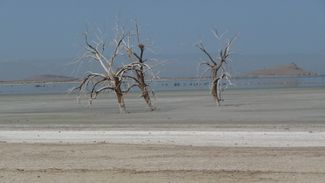Salton Sea - The Talks Continue
Last updated 6/25/2016 at 8:48am
The California Natural Resources Agency are continuing their tour of cities affected by the issue of the Salton Sea. A public workshop Thursday June 16, in El Centro's Imperial Irrigation District auditorium, where interested parties were informed of the progress regarding plans to address the exposed playa surrounding the Salton Sea.
"The purpose of this first set of meetings is to introduce this (issue)," said Bruce Wilcox, assistant secretary for the Salton Sea policy at the California Natural Resources Agency. "One of the task force goals was to be more transparent and to have more involvement."
Wilcox led the presentation and answered questions and comments from the audience.
Concerns centered on health aspects such as asthma and cancer, and the possibility they could dramatically rise as the drying sea dries and lack of funding to implement ideas that have already been presented in order to save it.
"I've lived in Salton City for the past seven years and I want solutions," remarked Ramon Noriega, who submitted his statement by a comment card offered at the meeting. "We've been studying the SS for too long, for 30 years or more. It is time to do something positive."
Several initial projects have been researched and tested, including treating exposed playa with magnesium chloride via crop-dusting, which would clump the contaminates together, making them too heavy to be picked up easily by the wind.
"Magnesium chloride is not the most benign product. At high concentrations it could be injurious to wildlife, so we're looking for other solutions," Wilcox admitted.
More realistically, Wilcox presented a plan for building a series of levies around the sea, which would allow sections of the playa to be flooded with up to a foot of water. Additional analysis is needed to see if levies are a viable solution. Other options included geothermal facilities and plowed ridges perpendicular to the wind, which would reduce dust-up. Wilcox noted that all the plans not only need further development, but financial support.
"We don't have the money to fund it all. That's a fact," he said. Current funding sits at $80 million which falls far short of the projected $2.5 to $3 billion needed.
While the presentation was thorough in explaining the possible solutions to the falling water levels, as well as possible sources of funding from both the state and federal levels, attendees were left wondering what efforts if any have been made to predict the health effects to residents if the funding does not come through.
"Perhaps it should've been done," said Wilcox. "I think the county is talking about doing a baseline health assessment now, which is a good idea."




